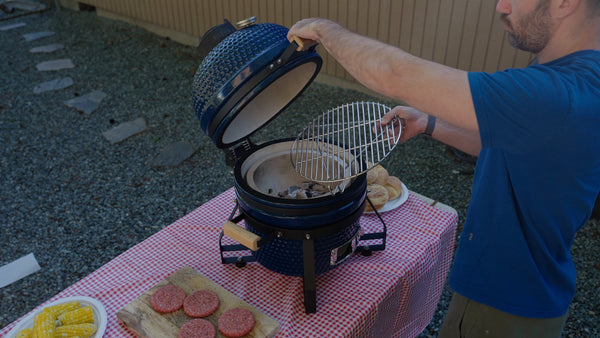
Chefs and Home Cooks: Grilling vs. Roasting — Which is Best for Your Kitchen?
Every chef and home cook faces a classic kitchen question: grilling vs. roasting— which is best? Both techniques can transform ingredients into spectacular meals, but each brings its own advantages, flavor profiles, and ideal uses. Understanding their differences empowers you to choose the best cooking method for any dish, whether you’re craving the smoky char of a steak or the tender juiciness of a roasted chicken. This guide explores the essentials of both methods, compares their strengths, and shows how versatile equipment like the Vessils Kamado Grill bridges the gap for home cooks and professionals alike.
Understanding Grilling: The Art of Direct Heat
Grilling uses direct, intense heat—usually from below—to cook food quickly, producing the signature Maillard browning, grill char marks, and unmistakable smoky flavor. It’s perfect for steaks, burgers, chicken pieces, seafood, and quick-cooking vegetables. Charcoal, gas, and kamado grills are all popular choices, with the Vessils Classic Full Size Grill serving as a prime example of a versatile, high-heat cooker. For setup tips, see How to Setup for Grilling on a Kamado Grill. Beginners can also check out the Beginner's Guide to Char-Grilling for foundational skills.
Understanding Roasting: The Power of Radiant Heat
Roasting relies on indirect, radiant heat—typically in an oven or a kamado set for indirect cooking—to cook food evenly. This method yields a tender interior and a beautifully browned, sometimes crispy, exterior. Roasting is ideal for whole chickens, large cuts of meat, root vegetables, and even baked goods. Essential equipment includes ovens, roasting pans, and kamado grills with accessories like the Vessils Ceramic Pizza Stone for indirect heat. For details, see How to Setup for Roasting on a Kamado Grill.
Grilling vs. Roasting: Key Differences & Similarities
-
Heat Source & Application: Grilling uses direct, high heat; roasting uses indirect, consistent heat.
-
Flavor Profile: Grilling delivers smoky, charred notes and intense flavors, while roasting develops rich, caramelized, and savory profiles.
-
Texture: Grilled foods have a crispy, seared crust; roasted foods are uniformly browned and tender.
-
Temperature Control: Grilling often involves higher, fluctuating temps; roasting requires steady, moderate heat. Both benefit from precise monitoring—use a Vessils Thermometer and see How to Control Temperature in a Kamado Grill and Choosing the Right Cooking Temperature for Grilling.
-
Versatility: Modern kamado grills can handle both techniques with ease. See Vessils Grill Accessories for tools that enhance versatility.
-
Safety: Always use High Heat Gloves when handling hot surfaces.
Fire Management for Grill Masters: Keeping Your Heat Right
Controlling your fire is the linchpin of great grilling and roasting. Airflow (via top and bottom vents) regulates oxygen and thus temperature—open vents for higher heat, close for lower. Charcoal arrangement (direct vs. indirect zones) and fuel management are key, especially for longer cooks. Kamado grills, with their ceramic insulation and precise vents, excel at maintaining stable temps. For more, see What Charcoal is Best for Kamado Grills? and How to Control Temperature in a Kamado Grill. Always monitor with a reliable thermometer.

High-Heat Grilling Techniques: Searing, Caramelizing, and More
High-heat grilling (450°F/230°C+) is all about achieving a perfect crust and deep caramelization. The Maillard reaction creates rich, complex flavors and grill marks. Techniques include:
-
Direct Searing: For steaks, chops, and fish—see Seared Sesame Crusted Tuna Steaks and Grilled Steak Fajitas with Bell Peppers.
-
Flash Grilling: For shrimp or thin veggies.
-
Reverse Searing: Start low, finish high for even doneness and a great crust.
Tips: Preheat thoroughly How to Fire Up the Kamado for the First Time, clean and oil grates, don’t overcrowd, and always use a thermometer. Kamado grills excel at reaching and holding high temps.
Pros and Cons for Chefs & Home Cooks
Grilling Pros:
-
Intense, complex flavors and char marks
-
Fast for thinner cuts
-
Enjoyable outdoor experience
-
Fat drips away for lighter dishes
Grilling Cons:
-
Less forgiving for delicate foods
-
Weather-dependent
-
Grate cleanup can be tough
Roasting Pros:
-
Consistent, predictable results
-
More hands-off—great for multitasking
-
Tender, juicy interiors
-
Deep, caramelized flavors
Roasting Cons:
-
Generally slower
-
Lacks smoky flavor (unless using a kamado)
-
Needs oven space or a versatile grill
Which is Best for Your Kitchen?
Consider your desired outcome, time, equipment, skill level, and dietary goals. Grilling is perfect for quick, flavorful meals and outdoor fun, while roasting excels for larger cuts and hands-off cooking. Kamado grills, like those from Vessils, offer unmatched versatility, letting you grill, roast, and even smoke with one investment.
Conclusion: Master Both, Elevate Your Cooking
Both grilling and roasting are essential techniques for any cook. Mastering each expands your culinary repertoire and lets you create a wider range of delicious dishes. Explore Vessils' All Accessories to enhance your cooking, and find inspiration for your next meal in the Recipes Blog Hub.
